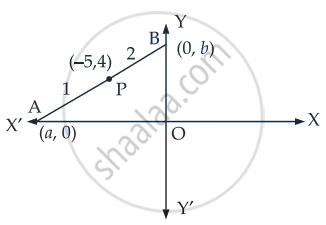Advertisements
Advertisements
प्रश्न
If the intercept of a line between the coordinate axes is divided by the point (–5, 4) in the ratio 1 : 2, then find the equation of the line.
उत्तर
Let a and b be the intercepts on the given line.
∴ Coordinates of A and B are (a, 0) and (0, b) respectively
∴ – 5 = `(1 xx 0 + 2 xx a)/(1 + 2)`
⇒ 2a = – 15 .......`[(because "X" = (m_1x_2 + m_2x_1)/(m_1 + m_2)),("and" "Y" = (m_1y_2 + m_2y_1)/(m_1 + m_2))]`
⇒ a = ` (-15)/2`
∴ A = `((-15)/2, 0)`
And 4 = `(1 xx b + 0 xx 2)/(1 + 2)`
⇒ 4 = `b/3`
⇒ b = 12
∴ B = (0, 12)

So, the equation of line AB is
y – y1 = `(y_2 - y_1)/(x_2 - x_1) (x - x_1)`
y – 0 = `((12 - 0)/(0 + 15/2)) (x + 15/2)`
⇒ y = `(12 xx 2)/15 (x + 15/2)`
⇒ y = `8/5(x + 15/2)`
⇒ 5y = 8x + 60
⇒ 8x – 5y + 60 = 0
Hence, the required equation is 8x – 5y + 60 = 0.
APPEARS IN
संबंधित प्रश्न
Find equation of the line parallel to the line 3x – 4y + 2 = 0 and passing through the point (–2, 3).
Two lines passing through the point (2, 3) intersects each other at an angle of 60°. If slope of one line is 2, find equation of the other line.
If p is the length of perpendicular from the origin to the line whose intercepts on the axes are a and b, then show that `1/p^2 = 1/a^2 + 1/b^2`.
Prove that the product of the lengths of the perpendiculars drawn from the points `(sqrt(a^2 - b^2), 0)` and `(-sqrta^2-b^2, 0)` to the line `x/a cos theta + y/b sin theta = 1` is `b^2`.
The hypotenuse of a right angled triangle has its ends at the points (1, 3) and (−4, 1). Find the equation of the legs (perpendicular sides) of the triangle that are parallel to the axes.
Find the equation of a line making an angle of 150° with the x-axis and cutting off an intercept 2 from y-axis.
Find the equation of a line which makes an angle of tan−1 (3) with the x-axis and cuts off an intercept of 4 units on negative direction of y-axis.
Find the lines through the point (0, 2) making angles \[\frac{\pi}{3} \text { and } \frac{2\pi}{3}\] with the x-axis. Also, find the lines parallel to them cutting the y-axis at a distance of 2 units below the origin.
Find the equation of the bisector of angle A of the triangle whose vertices are A (4, 3), B (0, 0) and C(2, 3).
Find the equation of a line for p = 4, α = 150°.
The length of the perpendicular from the origin to a line is 7 and the line makes an angle of 150° with the positive direction of Y-axis. Find the equation of the line.
Find the value of θ and p, if the equation x cos θ + y sin θ = p is the normal form of the line \[\sqrt{3}x + y + 2 = 0\].
Reduce the following equation to the normal form and find p and α in \[x + \sqrt{3}y - 4 = 0\] .
Reduce the following equation to the normal form and find p and α in y − 2 = 0.
Reduce the equation 3x − 2y + 6 = 0 to the intercept form and find the x and y intercepts.
Find the point of intersection of the following pairs of lines:
bx + ay = ab and ax + by = ab.
Find the point of intersection of the following pairs of lines:
\[y = m_1 x + \frac{a}{m_1} \text { and }y = m_2 x + \frac{a}{m_2} .\]
Find the coordinates of the vertices of a triangle, the equations of whose sides are
y (t1 + t2) = 2x + 2a t1t2, y (t2 + t3) = 2x + 2a t2t3 and, y (t3 + t1) = 2x + 2a t1t3.
Find the area of the triangle formed by the line y = 0, x = 2 and x + 2y = 3.
Find the area of the triangle formed by the line x + y − 6 = 0, x − 3y − 2 = 0 and 5x − 3y + 2 = 0.
Find the projection of the point (1, 0) on the line joining the points (−1, 2) and (5, 4).
Find the values of α so that the point P (α2, α) lies inside or on the triangle formed by the lines x − 5y+ 6 = 0, x − 3y + 2 = 0 and x − 2y − 3 = 0.
If the lines ax + 12y + 1 = 0, bx + 13y + 1 = 0 and cx + 14y + 1 = 0 are concurrent, then a, b, c are in
Find the equation of a line which passes through the point (2, 3) and makes an angle of 30° with the positive direction of x-axis.
Prove that every straight line has an equation of the form Ax + By + C = 0, where A, B and C are constants.
A line passes through P(1, 2) such that its intercept between the axes is bisected at P. The equation of the line is ______.
Find the equation of the line which passes through the point (– 4, 3) and the portion of the line intercepted between the axes is divided internally in the ratio 5 : 3 by this point.
Reduce the following equation into intercept form and find their intercepts on the axes.
3x + 2y – 12 = 0
